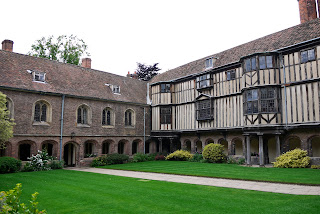Jesus College
We were in Cambridge for a College lunch and afterwards we decided to work off the wine with a nice stroll around some of the colleges. I chose a route to complement the short Trinity to Corpus walk we did in January and the even shorter Round Church to Clare one we did in 2009.
We walked from St Johns along Jesus Lane to Jesus to start the walk proper. The gatehouse is set back an unusually long way from the road and makes an especially imposing entrance. The college was founded in 1497. Its founder, Bishop Alcock of Ely suppressed a nunnery and took over its buildings in a fashion that sounds like a rehearsal for Henry VIII's Dissolution 40 years later, but apparently there were only two nuns at the time, so it was not as harsh an act as it sounds.
We admired the proportions and calm of Cloister Court, the original core of the college, although later altered.
We should really have paused to visit the chapel with its Morris and Co stained glass (designed by Burne-Jones) and Pugin tiles and glass, but we were a bit limited for time. OK, I admit that there was a need to get back home in time for the final of Euro 2012. I am sure there will be another opportunity.
From Jesus we followed a backstreet route to Christ's College, founded in 1442. Through the fine gateway and into the splendid 16th century First Court.
An archway in one corner leads to the newer (19th and 20th century), and much less interesting, parts of the College, but it is adorned on both sides by cheerful painted plaster figures.
We retraced our steps and turned into St Andrews St to walk along to Emmanuel College, previously unknown to me, founded in 1584. We were transfixed by the view across Front Court to Wren's Chapel of 1666 with its adjoining colonade.
As with Christ's, we found the newer buildings to be of much less interest and headed back through the gate, turning right and then left into Downing Street.
At the end we turned right into Trumpington St and paused to admire the facade of Pembroke College, founded in 1347. The two oriel windows are original, according to Pevsner, but the whole range was covered with ashlar in the 18th century. The chapel, visible at the far end, is the first building of Christopher Wren, and was consecrated in 1665.
Now left into Silver St, with a look back to St Botolph's church, with its fine tower dating from about 1400. We were a bit disappointed by the whitewashed interior.
We now went into Queens', narrowly beating the 4.30 closing time. This is not in fact a misplaced apostrophe: the college was founded and re-founded three times in the 15th century and two of the founders were queens (Margaret of Anjou and Elizabeth Woodville).
The handsome gatehouse leads to Old Court with a, dare I say, striking sundial of 1733.
From here a passageway leads to Cloister Court and the half-timbered President's Gallery of about 1540. Pevsner describes it as "perhaps the most loveable of all Cambridge courts".
And next up is the famous Mathematical Bridge, here viewed from the Silver Street bridge.
It is widely believed that the bridge was built by Isaac Newton without nails, later disassembled by students or fellows and rebuilt with the bolts you see today because they could not match Newton's ingenuity. Sadly the truth is more prosaic: it was built in 1749 by James Essex to the design of William Etheridge and has always had bolts. The Queens' College website is remarkably scathing in debunking the "baseless" stories told about it.
We turned right at the end of Silver St to then follow the backs to St John's where we had parked. What better way to end this post than with a picture of King's College chapel seen from across the Cam?
Conditions: mild and cloudy, with a threat of rain which resulted in one sharp shower.
Distance: about 3 miles.
Rating: four and half stars.
Note: This is my most recent walk in Cambridge. Earlier walks were from Round Church to Clare and from Trinity to Corpus Christi.











No comments:
Post a Comment